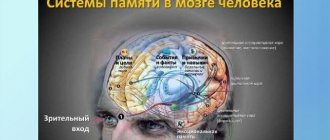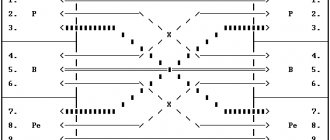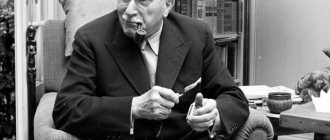Personality structure
tags:
Personality, Man, Structure, Social, Process, Substructure, Psychology, Property FEDERAL AGENCY FOR EDUCATION
State educational institution of higher professional education
STATE UNIVERSITY OF MANAGEMENT
Institute of Psychology and Sociology of Management Department of Sociology and Psychology of Management
Essay
in the discipline: “Personality Psychology”
on the topic: “Personality structure”
Content
Introduction
- General idea of personality
- Psychological structure of personality. “Elements” included in its structure
- Ideas about personality structure in Russian psychology
Conclusion
Bibliography
Introduction
Of essential importance for psychology is, first of all, an understanding of the very concept of personality. In fact, what is personality and what is the relationship between this concept and the related concept of man. Let's try to approach these questions genetically.
In general human development, two interconnected lines are usually observed - biological and social. These two lines can be clearly traced if we look at the process of human development from the moment of his birth. When a child is born, they say that a person was born as a biological being, but it is by no means possible to say that a personality was born. The development of biological inclinations and properties characterizes the process of functional maturation and formation of a person in the future. He develops a skeleton, muscles, as well as internal organs and systems. The process of biological maturation and change in a person is manifested in the age stages of his development and behavior and finds its expression in the specific biological features of childhood, adolescence, adulthood and old age.
However, the process of human biological development is thus combined with the acquisition of a significant number of social properties and qualities that characterize him as a social being. For example, from the age of one and a half months, a child begins to smile at the sight of loved ones, then masters speech, acquires the ability to walk upright, acquires skills and habits of handling things and objects, as well as behavior in the family and on the street, and begins to perform certain work duties. In the future, he enriches himself with knowledge, learns moral norms and rules, learns to follow fashion, develops the ability to more successfully perform a particular job, etc. At the same time, it is characteristic that speech and various skills and habits of behavior and work activity that are developed in children of the same nationality, but living in different social and living conditions, are different. This shows that the named social properties and qualities are not innate, but are formed in a person during his lifetime.
2 pages, 631 words
A) the process of development of an individual from birth to death
... to innate, individual personality characteristics? B) temperament D) talent 45. Ontogenetic development of a person is A) the process of development of an individual from birth to death 46. The first psychology laboratory was opened D) C. ...
Thus, being a biological being, a person in the process of his life produces and develops in himself many social properties and qualities that characterize his social essence. That is why he is considered in science as a biosocial being, as a subject, i.e. protagonist of historical activity and knowledge. Consequently, the concept of man synthesizes (combines) both his biological and social (public) properties and qualities. psychological personality social
The concept of personality includes only the social properties and qualities of a person, which, as shown above, include speech, consciousness, various habits, etc. and which make him a social being. The biological characteristics of a person are not included in this concept. That is why philosophy notes that the essence of a person is not her beard, not her blood, not her abstract physical nature as such, but her social quality. The property of being a person is associated not with the physical existence of a person, but with his social qualities. This allows us to conclude: the concept of “personality” characterizes the social essence of a person and denotes the totality of his social properties and qualities that he develops during his lifetime.
Since personal qualities are formed during life, it is quite understandable that in some people they can be expressed more clearly, in others - weaker. The question arises: by what criteria can one judge the degree of personal development of a person?
Psychologist S.L. Rubinstein wrote that a personality is characterized by a level of mental development that allows it to consciously manage its own behavior and activities. That is why the ability to think about one’s actions and be responsible for them, the ability to act autonomously, is an essential sign of personality.
1. General idea of personality
A.V. Petrovsky characterized personality in the system of interpersonal relations, in connection with which he identified three aspects of personality: intra-individual, which reflects the properties inherent in the subject himself; interindividual, considering the characteristics of the individual’s interaction with other people; and meta-individual, which describes the impact of a given personality on other people. [5].
2 pages, 909 words
Principle of development in psychology 2
... also develop in the development of the motivational sphere of the individual, ensuring a stable logic of his behavior in changing life situations. The driving forces of development themselves develop during this process, gaining...
L.I. Antsyferova defines personality as a person’s way of being in society, in specific historical conditions; it is an individual form of existence and development of social connections and relationships. [5]. Many other definitions of personality are given in the book by I.B. Kotova Personality psychology in Russia, which analyzed ideas about personality among domestic philosophers and psychologists, from the end of the last century to the present time. [6].
All psychologists agree that a person is not born, but rather becomes, and for this a person must make considerable efforts. He must master speech, and then with its help many motor, intellectual and socio-cultural skills. Personality is considered as a result of the socialization of the individual, during which he assimilates the traditions and system of value orientations developed by humanity. The more a person was able to perceive and assimilate in the process of socialization, the more developed a person he is. [2]. Is it possible for a person not to be a person? Is a one-year-old child, a mentally disabled person, or a sophisticated criminal a person?
These questions have repeatedly become the subject of discussions among psychologists, philosophers, doctors and lawyers. It is difficult to answer them unambiguously, since each case requires specific consideration, but most scientists are inclined to recognize all of the listed categories of people as having the right to be called a person with certain reservations. Thus, it is more correct to call a child, teenager and young man an emerging personality, because they still have only the makings of a mature personality, which must further develop and form into an integral system of properties. As for mentally disabled people, the degree of preservation of their personality can be very different: from small deviations from the norm in neuroses to significant personality destruction in severe cases of schizophrenia.
Their worldview, behavioral motivation, and thinking characteristics are qualitatively different from similar characteristics of a healthy person, therefore, in such cases, it is more correct to use the concept of a pathological or abnormal personality. Criminals recognized as mentally healthy are asocial individuals, since they have turned all the knowledge, skills and abilities they have accumulated against the society that formed them. Personality can be lost by a person due to serious illness or extreme old age, which is manifested in the lack of the ability to recognize oneself as a subject of activity, orientate in space and time, etc.
In this case, we can talk about a degraded personality [2]. L.I. Antsyferova considers the main way of existence of an individual to be constant development aimed at realizing one’s capabilities in activity and communication. As soon as a person stops efforts to develop his mental functions, social and professional skills and abilities, personality regression immediately begins [5]. What are the criteria for determining the level of maturity of an individual? When answering this question, it is better to rely on the ideas of I.M. Paley and V.S. Maguna about three sides of personality.
The first side describes the internal structure of the personality through such characteristics as hierarchy and integrity. Hierarchy is understood as the subordination of lower functions (processes, properties) to higher ones in the process of development. For example, the satisfaction of vital needs in a mature person is subordinated to higher needs. Integrity means the uniformity of human behavior in changing conditions and circumstances. Consequently, a mature person acts not under the influence of momentary factors, but on the basis of his value system, which has developed over the years [4].
9 pages, 4059 words
Psychology of the criminal personality. Psychological characteristics...
... personalities. Unfavorable features of individual mental processes, states and biologically determined properties can only contribute to the action of this cause. The socio-demographic substructure includes such personality traits as ... the degree of active resistance to negative environmental phenomena. Human substructures turn out to be so organically connected that the biological does not...
The second side of the personality reveals the features of its interaction with the objective world through the characteristics of its activity and independence. A mature person always takes an active life position in any activity in which she is engaged. She determines for herself the meaning, goals and objectives of the activity and looks for optimal ways to carry it out. Sometimes she does not even expect remuneration for her work if this work brought her pleasure. This distinguishes her from an immature personality who waits for instructions, encouragement and does not go beyond the boundaries set from the outside in the process of doing work.
A mature person is able to carry out activities even under the threat of punishment from the authorities and the possibility of losing many life benefits. There are many examples of self-denial in the name of one’s life’s work in the history of Russia, starting with the Decembrists and ending with the dissidents of the 60-80s. The third side of personality characterizes the characteristics of its relationships with other people. Among the many features of M.M. Paley and V.S. Magun singles out only one, but very significant, criterion of maturity - the ability of an individual to contribute to the growth and development of the personalities of other people. Personality, according to S.L. Rubinstein, with the certainty of his attitude to life, forces others to determine themselves. To influence the worldview of other people, a person must accumulate a large store of wisdom and acquire power over them (spiritual, religious, political, etc.).
The spatiotemporal breadth of this influence ultimately determines the scale of the individual. Most often, this influence extends only to the person’s immediate environment, which is also not small. In other cases, a personality influences the minds of people for a certain period of time in a certain country. But there are personalities on a planetary scale who influence humanity with the example of their extraordinary lives and deeds across the thickness of centuries and the vastness of geographical distances. These people can serve as an example for us of the maximum development of what is called Personality. [2, 84]
2. Psychological structure of personality. “Elements” included in its structure
The elements of the psychological structure of a personality are its psychological properties and characteristics, usually called “personality traits.” There are a lot of them. But psychologists are trying to conditionally fit all this difficult-to-see number of personality traits into a certain number of substructures. The lowest level of personality is a biologically determined substructure, which includes age, gender properties of the psyche, innate properties such as the nervous system and temperament. The next substructure includes the individual characteristics of a person’s mental processes, i.e. individual manifestations of memory, perception, sensations, thinking, abilities, depending both on innate factors and on training, development, and improvement of these qualities. Further, the level of personality is also its individual social experience, which includes the knowledge, skills, abilities and habits acquired by a person. This substructure is formed primarily during the learning process and is of a social nature. The highest level of personality is its orientation, including drives, desires, interests, inclinations, ideals, views, beliefs of a person, his worldview, character traits, self-esteem. The substructure of personality orientation is the most socially conditioned, formed under the influence of upbringing in society, and most fully reflects the ideology of the community in which the person is included. [2]
16 pages, 7575 words
Personality problems in humanistic psychology
... it is necessary to carry out an analysis of individual cases; 2) study the formulation of personality problems in humanistic psychology; 3) personality properties are in a one-to-one relationship with each other, therefore it is necessary ... a person considers his existence as a specifically human essential feature (S. Jurard, V. Frankl, A. Maslow). Problems of interpersonal relationships, love,...
The differences between people are multifaceted: in each of the substructures there are differences in beliefs and interests, experience and knowledge, abilities and skills, temperament and character. That is why it is not easy to understand another person, it is not easy to avoid discrepancies, contradictions, even conflicts with other people. To understand yourself and others more deeply, you need certain psychological knowledge combined with observation.
In psychology, there are two main directions of personality research: the first is based on the identification of certain personality traits, the second is based on the determination of personality types. Personality traits combine groups of closely related psychological characteristics. [6]
Table 1. Hierarchical structure of personality (according to K.K. Platonov)
Brief name of the substructure This substructure includes Correlation of biological and social Substructure of orientation Beliefs, worldview, personal meanings; interests Social level (almost no biological) Substructure of experience Abilities, knowledge, skills, habits Socio-biological level (much more social than biological) Substructure of forms of reflection Features of cognitive processes (thinking, memory, perception, sensation, attention); features of emotional processes (emotions, feelings) Biosocial level (more biological than social) Substructure of biological, constitutional properties Speed of nervous processes, balance of processes of excitation and inhibition, etc.; gender, age properties Biological level (social is practically absent)
Trying to determine the necessary and sufficient number of substructures into which all known personality traits can be included, scientists, having tried numerous options, identified four. One of the criteria for distinguishing substructures from each other is the relationship between the biological and the social—not their share, but their significance for a given substructure. Man is a social being, so consideration of personality structure begins with substructures in which the social side is more important, and at the end - the more biologically determined parts of the personality.
4 pp., 1681 words
Psychological structure of personality, the role of stress in human life
... of a person that are of significant importance for himself and those around him. Let's consider the structure of personality: - this is a system of ideas about personality that generalizes the procedurally hierarchical substructures of personality with the subordination of lower substructures... properties Biological level (social is practically absent) Hierarchical structure of personality (according to K.K. Platonov) The most important components of personality structure...
-i substructure is called the orientation of the personality. These include: drives, desires, interests, inclinations, ideals, worldviews, beliefs. The personality elements (traits) included in this substructure do not have innate inclinations, but are completely socially conditioned and formed through upbringing. The most active and stable form of orientation is beliefs. The totality of them constitutes a person’s worldview, which can be passive - it is simply available. But the substructure of orientation also includes will - it is this that can give beliefs an active character, contributing to their implementation.
-I substructure is called experience. It combines knowledge, skills, abilities and habits acquired in society through education, but with a noticeable influence of biologically and even genetically determined human properties. Not all properties included here can be considered as personality properties. A skill that is just beginning to form or a one-time action is not yet a personality trait. But typical manifestations for a given individual, as well as consolidated knowledge, skill, and even more so ability and habit, are already indisputably a property of the individual. Experience can also be passive dead weight. But thanks to individual volitional skills, he can become active when knowledge and skills are not just “known”, but also used.
The -th substructure combines the individual characteristics of individual mental processes (functions): memory, emotions, sensations, thinking, perception, feelings, will. After all, we all have different memories, emotions, perceptions, etc. These individual characteristics, when consolidated, become personality traits. Some have a “fine perception of art,” another has a “leaky” memory, and a third has “a flurry of emotions over a trifle.” All components of this substructure are formed through exercise, that is, the frequency and method of using a given function. Since emotions and sensations are also characteristic of animals, we can say that in the personality traits of the 3rd substructure, the biological component begins to prevail over the social one.
. Ideas about personality structure in Russian psychology
The structural approach is a method of analysis in which an object is considered as a certain integrity that has a certain structure, i.e. a set of elements that have certain relationships with each other. It is used in various sciences to analyze complex objects; in psychology, such an object is the personality. Consideration of personality in terms of its structure and constituent components is a traditional and at the same time relevant approach to its study. If we turn to the history of the study of personality, we can be convinced that almost every researcher who tried to penetrate into the essence of this complex mental formation and understand the mechanism of its functioning came to the idea of the need to isolate individual elements and analyze the relationships between them. The criteria for dividing personality into separate blocks, as well as the conceptual positions of the authors, were extremely different and gave rise to fierce discussions, but the very idea of considering personality through the prism of its structure remained unchanged. Its vitality is explained, first of all, by the characteristics of the object of study itself - the individual, the most obvious and noticeable characteristics of which are integrity, complexity, secondaryity in relation to simpler mental functions. It is no coincidence that psychologists began to talk about personality structure long before the structural approach took shape as a research method in philosophy.
13 pages, 6072 words
Personality. Approaches to personality structure. Theories of personality. Structure...
... personality structure is defined as the individual originality of the relationship between individual properties of archetypes, individual blocks of the unconscious and conscious, as well as extroverted or introverted personality attitudes. Proponents of the humanistic theory of personality in psychology ... (perceive and interpret) a person’s personal experience. The structure of personality within the framework of this approach is considered...
Structural ideas in psychology arose as a reaction to atomism and excessive dismemberment in the analysis of the human psyche. According to M.S. Rogovin, one of the first attempts at a structural approach to the analysis of personality can be considered the concept of S. Freud, who considered a person as a structural unity of three parts: the Id, the Ego and the Super-Ego. The development of the structural approach in psychology was greatly facilitated by the work of Gestalt psychologists, in particular K. Lewin, devoted to the relationship between the part and the whole. With the development of philosophical concepts related to the concepts of structure and system, ideas about structure in psychology received reliable support. The greatest flowering of the structural approach to personality analysis in Russian psychology occurred in the 70s. But this was not a tribute to fashion; it was simply that domestic psychological science had by this time entered a new scientific stage of its development. The emergence of structural concepts in psychology indicates that it has reached a certain stage in the development of scientific knowledge.
Philosopher V.F. Sergeantov believes that each science goes through three levels of development: 1. phenomenological, in which the idea of an object is of an undifferentiated holistic nature; 2. substrate-phenomenological, characterized by an analytical approach to the object; 3. system-structural, in which, thanks to synthesis, the specific nature of an object is theoretically reproduced. [6]
In the philosophical encyclopedic dictionary, structure (from the Latin structura - structure, arrangement, order) is defined as a set of stable connections of an object that ensure its integrity and identity, i.e. preservation of basic properties under various external and internal changes. To conduct a structural analysis of any complex object, three basic conditions must be met: to identify the elements of which it consists, to study the nature of the connection between them; identify the mechanism of structure integrity that allows it not to change when the environment changes. When selecting elements, you must follow some rules. Elements must contain the main characteristics of the whole, and not be simply its parts. Their number should be sufficient to fully describe the personality, but not excessive.
There are two main ways to build a personality structure: empirical and theoretical. The empirical method is based on identifying the elements of the structure using the methods of mathematical statistics (most often factor analysis) to a large array of empirical data. The clusters or factors identified during processing serve as elements of the personality structure (as, for example, 16 factors in the personality structure proposed by R. Cattell).
12 pages, 5628 words
STRUCTURE AND PROPERTIES OF PUBLIC OPINION
... in accordance with the above argument, the following diagram of the basic structure of public opinion is more accurate: PUBLIC OPINION VOLITIONAL COMPONENT RATIONAL COMPONENT EMOTIONAL ... COMPONENT Modified diagram of the basic structure of public opinion Fig. 2.5. Let's now move on to the characteristics of the elements of the basic...
The theoretical method of constructing a personality structure is based on putting forward a theoretical principle that connects individual levels and elements. In Russian psychology, both methods of constructing a personality structure are presented. The empirical method is implemented in the works of V.S. Merlin, who, based on empirical research, came to a three-level personality structure. The theoretical approach to building a personality structure was implemented by K.K. Platonov, who chose the principle of the relationship between the social and the biological in their determination as the basis for identifying the levels of structure. K.K. Platonov not only proposed his concept of the dynamic functional structure of personality, but also paid great attention to the history of this issue in Russian psychology, which he outlined in detail in his work Structure and Development of Personality. The main criterion for identifying the elements of personality structure was the relationship between the biological and social in their origin.
On this basis, four personality substructures were identified:
personality orientation (beliefs, worldview, ideals, aspirations, interests, desires);
experience (knowledge, skills, abilities and habits);
personality traits that depend on the individual characteristics of mental processes (will, feelings, perception, etc.);
biopsychic properties (temperament, gender, age properties).
The substructure of orientation is the result of exclusively social determination, the substructure of experience is determined primarily by social factors, but also has an innate basis, the substructure of mental processes is formed under the predominant influence of innate factors with the participation of social ones, the substructure of biopsychic properties is determined only by biological factors. [3]
Along with the main criterion for identifying substructures of K.K. Platonov cites additional ones: the internal similarity of personality traits included in each of the substructures; type of formation of substructures; hierarchical dependence of substructures, in which each overlying substructure is determined by the underlying ones. According to K.K. Platonov, all known personality traits can be placed into these four substructures. The only exceptions are character and abilities, to which he assigns a special role. Character is not an independent substructure, but a general quality of personality superimposed on them. He looked at abilities similarly, arguing that any personality property included in any of the four personality substructures can and should be considered as an elementary ability if this personality property is professionally positively or negatively significant.
10 pages, 4719 words
The concept of personality. Personality structure
...in Russian psychology, attempts are being made to find out the general structure of personality. The approach of K.K. Platonov, who created the psychological concept of the dynamic functional structure of personality, is very characteristic in this direction. In the personality structure, K.K. Platonov identifies four substructures. According to him...
A fundamentally different approach to the analysis of personality structure is contained in the concept of V. S. Merlin. In his opinion, personality structure should be understood as the mutual connection and organization of personality properties. Personality properties are its components that cannot be further decomposed. At the same time, each personality trait is an expression of its orientation, character and abilities. It is formed in activity and at the same time, to one degree or another, depends on hereditary factors. Each personality trait is based on an attitude towards some aspect of reality. It is customary to distinguish such groups of relationships as relationships to other people, to work, to material objects, to oneself, to ideological and spiritual phenomena, to nature, etc.
Personality properties form the lower level of the personality structure. Based on the generality of relationships, a probabilistic connection can arise between personality properties, due to which the properties form groups, which he calls symptom complexes, which constitute the second level of the personality structure. Symptom complexes are characterized by volume, activity and stability. Volume is determined by the number of properties included in it, activity - by the strength of influence of these properties on human behavior, and stability - by the constancy of properties throughout a person’s life. There is a relationship between these characteristics: volumetric symptom complexes, as a rule, have greater activity and stability. The third level consists of three secondary factors that absorb all symptom complexes: ideological orientation, the desire for self-expression and the desire to satisfy material needs and organic drives. According to V.S. Merlin, they can form different hierarchical relationships among themselves, which determines the direction of the personality. It should be noted that the peak of research and discussions on the structure of personality occurred in the 70s, when structural and systemic analysis was popular in other sciences, and even the interdisciplinary yearbook System Research was published [6].
Conclusion
Attempts to determine the structure of personality and its components have been made for a long time. Since this subject of study, being one of the manifestations of the psyche, is intangible and cannot be touched with hands, different authors, in different psychological directions, have different concepts of personality structure. It depends on what you mean by personality. Psychology has gone through a number of stages, starting with an understanding of personality as a soul, ending with an understanding of personality as a person.
In Russian psychology much attention was paid to theoretical aspects, in Western psychology - to practical ones. Therefore, in the works of our psychologists, the question of personality and its structure is better worked out, theoretically substantiated, and a harmonious scientific system is created.
In conclusion, it is worth noting that neither individual personality traits nor the personality as a whole remain unchanged throughout a person’s life. But personality changes can be associated not only with its development as a result of growing up, but also with social decay, with senile degradation and with pathological development. A person can change for the better or for the worse. In addition, the variability of personality traits depends on the compensation of some underdeveloped personality traits by others, and on changes in the methods and extent of this compensation. For example, a memory defect in the same person in one case can be compensated by attention, and in another by intelligence. Thus, the personality structure is dynamic - changing, and not static (unchanging).
In works on psychology they write: “dynamic structure of personality.”
1. Asmolov A. Psychology of personality. Principles of general psychological analysis. - M., 2002.
2. Personality psychology. Lecture notes. //Guseva T.I., Karatyan T.V. — 2008.
. Psychology of Personality. //Guseva T.I. 2008.
. Psychology of Personality. (Tutorial) //Ed. Ermakova P.N., Labunskoy V.A. 2007.
. Robert Nemov. General psychology in 3 volumes - M., 2008.
. I.B. Kotova Personality psychology in Russia. - M., 2002.
Examples of similar educational works
Topic 1. Subject, tasks, structure of educational psychology
... development ~A4 Laboratory experiment in educational psychology is used: + for the study of mental functions - for the study of personality ... ~A4 The structure of the subjective properties of a teacher includes (2): ... in the interests of the individual and society ...
The concept of personality in sociology and psychology
... “personality” subsequently came to mean the real role of a person in public life. With the development of psychology into a separate science, personality ... “personality” in modern sociology. Based on the goals and objectives set, we are forming the structure of this...
Topic 1. Subject, tasks and structure of educational psychology
... Psychology reveals individual, age-related characteristics and patterns of development and behavior of people, ... psychology. 1. Education in a general cultural context Education is considered as a social institution, as one of the social substructures...
46-The concept of attention, functions, properties, types. Development of attention
... arise in a person in the process of work. They are a product of historical development. Labor is aimed at satisfying human needs. And... and forms that basic social operation. behavior of a person who. called voluntary attention. In order to …
Problems of personality and communication in Russian psychology
... orientation; * structure and dynamics of relationships. The integration of personal properties is represented in the character of a person and his inclinations. The structure of personality, according to Ananyev, is formed in the process of individual psychological development, which appears in ...
Features of human GNI. Development of speech in ontogenesis and its disorders
... and thus ensures the progress of culture. For the development of the second human signaling system, the first 6 years are of decisive importance... actively and independently using words with simple structure in speech. In the third year of life, the mobility of the articulatory...
Psychological psychology
Personal experience is the collection of social experience (socialization) of a person. This experience includes the knowledge, skills and abilities necessary for his life activities.
Knowledge is a system of scientific ideas about the laws of nature, society, education and development of man and his consciousness.
Skills are a person’s ability to work productively, perform high-quality and timely work in a new environment based on knowledge and skills.
Skills are automated components of target conscious activity.
The unit of regulation of personal behavior (self-control system) includes forms of mental cognitive processes, in particular: individual characteristics of feelings, perception, attention, memory, observation, imagination, thinking, language.
Biologically determined characteristics and qualities of personality:
- anthropological characteristics - race, gender, age, etc.;
- physical characteristics - body size and its structural and mechanical properties
- external anatomy of the body;
- functional and anatomical characteristics;
- biochemical characteristics and pathology of selected elements;
- Characteristics and types of temperament.
- derived from these basic substructures.
Sign:
- a set of basic, distinctive characteristics of a person, which are manifested in the peculiarities of his behavior and attitude to the surrounding reality
- holistic education of a person that determines the characteristics of his activities and behavior
- An ability is a person's intellectual property that is a necessary condition for the successful performance of certain types of activities.
The main source of personal activity is needs.
All aspects of personality are manifested in activity, and it is needs that force a person to act.
A need is a stimulus for activity that is recognized and experienced by a person as a need for something or as a lack of something.
Natural (of course) - directly ensures human existence in food, clothing, recreation, housing, etc. These are biological needs, but they are different from the needs of animals; the way a person satisfies them is social.
Spiritual or social needs (purely human). This is a necessity: verbal communication with other people, cultural knowledge (reading books, going to the theater, music, etc.).
Essence and concept
In psychology, the term “personality” is understood as a person who has a set of psychological characteristics that have a direct impact on actions and their significance in society. Each person is individual and therefore always different from the other.
There are also other scientific definitions of personality. For example, his role in society, experience and knowledge. This is a person who bears full responsibility for his life, controls his choices and has a sense of responsibility for his actions.
Thus, personality is a set of habits that have been developed over the years and a person’s preferences, his emotional mood and vitality, sociocultural experience and knowledge accumulated over many years of life. This is a unique set of human traits and characteristics at the psychological and physiological levels. It is also a human archetype that defines everyday behavior and the connection between society and the natural world. In addition, the personality is identified in terms of the manifestation of “behavioral masks” created for different life situations and groups of social interaction.
Personality is a relatively stable system of individual behavior, the core of which is self-esteem, created on the basis of the value judgments of other people and a person’s assessment of his environment.
The concept of personality does not have strict boundaries or frameworks: in everyday life it is understood, for example, as the character of the entire person as a whole
The term “personality” is inextricably linked with two more psychological concepts - individual and individuality. The first is understood as an individual person who has a set of qualities, both innate and acquired. Individuality is a system of characteristics and exclusive traits by which one person can be distinguished from another. It is on this, internal uniqueness, that personal uniqueness and the makeup of the human psyche depend.
Despite the similarity of definitions, they cannot be identified or equated with each other, because both terms describe individual aspects of human life. At the same time, it would also be wrong to excessively distance the concepts from each other. After all, each person is multifaceted, it is impossible to consider him exclusively from one side, like the visible side of the Moon.
Bibliography
- Antsiferova L.I. Psychology of personality formation and development / L.I. Antsiferova // Man in the system of sciences: collection of articles. - M.: Nauka, 1984 - pp. 426-434.
- Zeigarnik B.V. Personality theory in foreign psychology / B.V. Zeigarnik. - M.: MSU, 1985. - 128 p.
- Kamyshev E.N. Psychology and pedagogy: textbook / E.N. Kamyshev, L.I. Ivankina, I.A. Dubinina and others - Tomsk: TPU Publishing House, 2004. — — 79 p.
- Petrovsky A.V. What we know about ourselves and what we don’t know / A.V. Petrovsky. - M.: Pedagogy, 2005 - 160 p.
- Stolyarenko L.D. Psychology and pedagogy in questions and answers: textbook / L.D. Stolyarenko. - Rostov N.D., Phoenix N.D., 2001 - - 576 p.
- Hjell L. Personality theories: foundations, research and application. lane from English / L.Hjell, D.Ziegler. - St. Petersburg: Peter, 2003. - 606 p.








